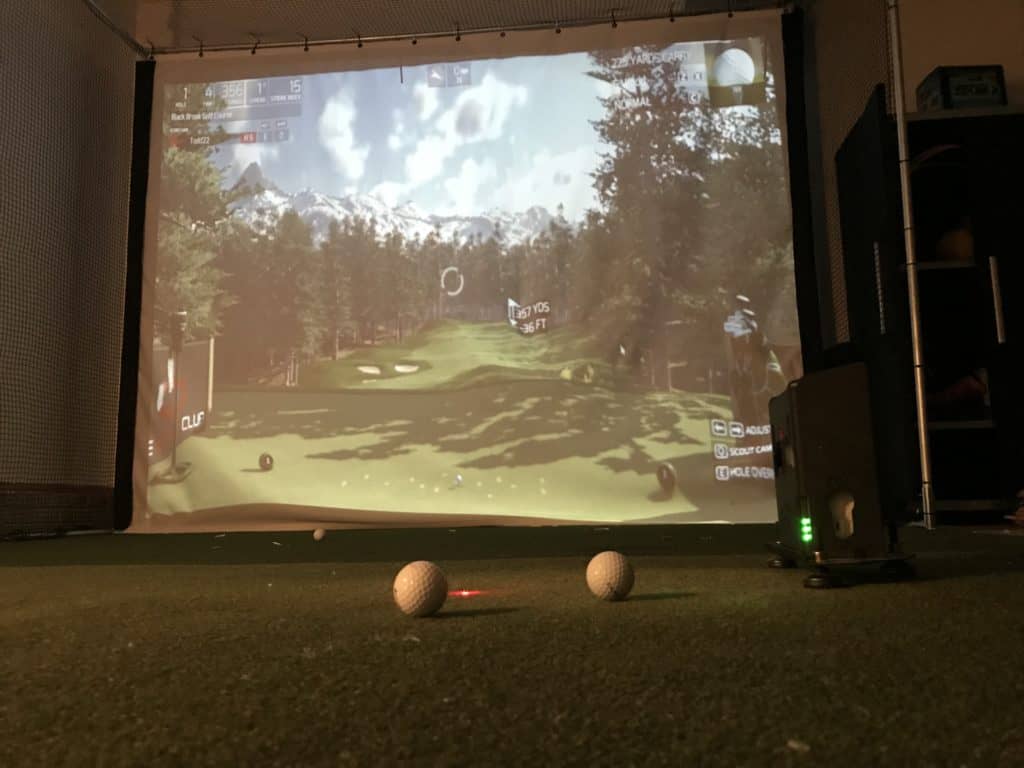Take some notes to improve your own golf game:
- Yardages
- Club Selections
- Wind Patterns
- Hazards
- Putting Green Details
- Aim Points
- Bail Areas
I am sure you have witnessed a PGA Tour player or a golfer on television writing something in a notebook. They seem to be really focused at times on what their notebook contains or taking copious notes on certain holes.
As someone always looking to improve, you start to wonder if these golf notebooks can help you and your game in the future.
Professional golfers have the advantage of playing a certain course 6 to 7 times in a week with 4 of those rounds being competitive rounds and the 2-3 prior to the tournament being practice rounds.
As some golfers prepare for Major Tournaments, they may head to the course several times in advance to play the course and learn as much as possible.
Keeping a golf notebook during these practice rounds and actual competitive rounds play a major role in ensuring the golfer is giving themselves the best chance to handle all of the variables that a golfer is faced with during a course of a round of golf.
I am sure you have wondered what golfers write in their notebooks. Here is a quick list and many details found below.

What Do Golfers Write In Their Notebooks?
Many competitive golfers will utilize a notebook or yardage book and record the following:
- Yardages
- Club Selections
- Wind Patterns
- Hazards
- Putting Green Details
- Aim Points
- Bail Areas
Many golfers will start a round of golf with a plan for each hole.
Prior to arriving to the hole or even starting their round, they will consider what they plan on hitting off of each tee shot and having a plan for attacking each hole and shooting the best score possible.
Every golfer should consider their game plan and utilize a notebook or yardage book to takes these detailed notes to help them score their best on each round that they play.
While many of us may only play courses once or twice in a lifetime, the courses you play more often can have a notebook that you create for each round.
Learn from the professionals who are trying to make a living and survive on tour to make their careers last as long as possible.
Here are some details on each of the items found on the list above.
1st Item: Yardages
For the more serious and competitive golfer, keeping track of distances on all approach shots is vital. This helps you prepare for the round and make adjustments. Logging this information over time will help with club selection.
Golf is not only a game of hitting it solid and controlling your ball, but so much goes into the proper decisions a golfer is faced many times throughout a round.
A golfer will take note of the yardage and the club utilized and the result. This will be a quick reminder if a similar distance comes up. It is strange, but some holes seem to play longer or shorter and documenting this in a notebook can be helpful.
The yardages also play a key role on the tee box as well on par 4s and 5s. Having notes of where certain fairways begin or end of where hazards come into play can and will be helpful!

2nd Item: Club Selections
The golfer that is able to take detailed notes on yardages, will also take detailed notes on club selections.
This is important especially on par 3s. Having a bank of ideas on what you have hit from different distances can help the golfer pull the right club. HOpefully, it provides confidence that the golfer has the right club. One of the quickest ways to ensure a bad shot is to be indecisive over a golf shot.
Gain that clarity and confidence you are seeking by taking those detailed notes on distances and the club you selected. Over the course of time you will be able to make the better decisions more times than not.
Even noting what you hit off of certain tees on par 4s and 5s will be beneficial in the long run.

3rd Item: Wind Patterns
Make sure as you mark the distance you had left and the club you selected that you make sure you always note the wind direction and intensity. You can also mark the prevailing wind and how the ball responded.
You will see the professionals just completely confused on the 12th hole at the Masters. This is a result of an inconsistent and difficult to read wind pattern on each and everyday. The green is also only about 11 yards deep which doesn’t leave much margin for error.
Wind is one of the most difficult variables to deal with and in making a club selection. If you have the detailed notes you will once again be able to make a confidence decision and go with it.
Also, take note of if you hit a stinger type shot, full shot, rode the wind or battled the wind. These little notes will help you out!
4th Item: Hazards
One of the most difficult variables when playing a course for the first time is knowing exactly where hazards start and end. There is nothing worse than hitting a solid drive down the middle only to get to the ball and find a little creek that runs across the fairway.
Make detailed notes of where hazards begin and end and what the carry distances are on each hazard.
I have been caught by surprise with bunkers in the middle of fairways or thinking I have more distance to a water hazard than is really there.
There is nothing more devastating, so make sure you make note of these hazards and be prepared. This will help you best manage your game and play your best!
The more you play a course, the more you get to know it, but even after the first practice round or two, you can start to have the same confidence you have with a cours you have played 50 times or more.
5th Item: Putting Green Details
Ever play a green for the first time and leave just absolutely confused during your round? We have all been there! Golf is a frustrating game when you don’t know the greens.
One of my most frustrating things is to hit a green towards the middle and back and have the shot run off the green. This can be mind boggling as you chip back towards the green.
Not only should you note the break of putts, but also where greens run out and where to avoid when hitting those approach shots.
When putting, make special notes of the general flow of greens and which way putts break on each and every green.
If you are fortunate enough to play a practice round prior to a tournament, if you have the time, hit greens on the different portions of the green. Today, many green complexes are large and complex and the more you can play the more comfortable you can be on tournament day.
6th Item: Aim Points
Many courses have multiple blind shots throughout a round of golf. Making notes of where you aimed and different objects off in the distance can play a major role in your success.
The more hilly a course is the more you need to make special note of where you aimed. One of my courses I played a ton as a kid had at least 6 blind tee shots.
Making sure you have a solid start line is essential to play solid on this course. I am sure there are plenty of these courses throughout the world.
Also on approach shots into greens, make sure you know the back and front distances and where you want to aim.
7th Item: Bail Areas
Most golf holes have an element of risk and rewards on the tee shot and the approach shot into the green. Make note of the best areas to miss and utilize your shot shape to your advantage.
If you play the percentages throughout the course and over a tournament, you will benefit in the long run.
You might make a couple more pars and a couple less bogeys. There is nothing worse than a great ball striking day that doesn’t match the score due to poor decisions or taking on risks that were too large.
Make note of these areas and play smart. The smart golfer doesn’t have to play scared, but should pick spots to be aggressive.
Tools to Assist in Game Management and Creating Your Course Notebook
I believe every shoulder should have a GPS based watch or a Golf Rangefinders to measure distance. The great thing about the GPS based watch is that it provides a front, middle, and back distance on every approach shot you will play.
Having these distances will help a great deal and set you up for success.
The Golf Rangefinder is a golfer’s best friend during any round. Whether you are taking notes or playing a golf course for the first time. These rangefinders are very versatile as you can know the distance to hazards or to the pin.
The main struggle might be knowing the front, middle and back distances on approach shots, but it does give you an exact distance to a pin on each approach shot.
I think to have both tools accessible to you during practice rounds can truly set you up for success!
Two Great Options Here:
How To Better Learn Your Distances
One last item you can have in your notebook is the distance that you hit each iron and club in your bag. I have been fortunate enough to build a golf simulator in my garage and utilize a SkyTrak Launch Monitor.
I can take my SkyTrak to the driving range or utilize in my garage and get a great idea on the average that I hit each club.
I would highly recommend Rain or Shine golf due to the great customer service and Financing Options.
The SkyTrak has helped me play better golf through better ball striking and I have reduced my average scores by 4-6 shots over 18 holes. One part of this equation is knowing my yardages and being able to have better distance control from the immediate feedback provided by the SkyTrak.

I have really been able to improve on these three fundamentals:
The Stack and Tilt Instructors said it best when they described what they believed were the fundamentals of golf. They explained it somewhat similar to this:
- Fundamental #1: The golfer’s ability to control the bottom of the golf swing. The best golfers will hit the ground in the intended spot, close to 100% of the time.
- Fundamental #2: The golfer’s ability to control the curve of the golf ball. The best golfers are able to start the ball to the right or left of the target line and have the ball curve towards the target without the ball over curving past the target.
- Fundamental #3: The golfer’s ability to have enough power to play the golf course. This means they are able to hit the ball far enough to play the course in regulation.
One last items I must share is how to get better with Funadmental #3 – Having enough distance to play the course. You have to check out SuperSpeed Golf.
This overspeed based training system only takes 10-15 minutes every other day and you can see results of 5-8% increase in swing speed the first time you use the system.
Check it out here and use discount code Golfjourney365 for a $10 discount.
Take Action – What You Can Do Today to Get Better
What does this mean for you? I believe in the following recipe to get better:
1 – Improve your motion in the golf swing by identifying a golf instructor. Here are some options:
Here is a list of golf instructors that we have reviewed:
2 – Train to swing faster and improve your swing speed. Here are some options:
Looking to gain more Speed and Distance in your swing. Two Options:
3 – Understand course strategy and work to break through your next barrier. Here is a series on breaking through:
We have provided guides on how to break 100, 90, 80 and 70. Check out more below, if interested.
4 – Practice Frequently
Did you know that I build a golf simulator in my garage and have played over 500 rounds of golf on my SkyTrak system? It has been a game changer and one worth checking out. Here are some of my other posts on golf simulators frequently asked questions:
- Is a Golf Simulator Worth It?
- How to Build a Golf Simulator?
- What is the Best Golf Simulator?
- Golf Simulator Accessories?
- How to Build a Golf Simulator for under $7000
- Top 11 Reasons to Buy a SkyTrak
- How to Build a Golf Simulator for Under $1000
- Why Build A Golf Simulator?
- What Space is Needed?
- Can A Golf Simulator Improve My Game?
- How Much Does A Golf Simulator Cost?
- Don’t Forget to Check out our 15 best golf swings of all time.
I am an amateur golfer on a journey to get better, enjoy the game as often as possible and share my passion and knowledge with others. I have coached high school golfers at a high level and have a great passion for the game and want to give back. I enjoy learning about the golf swing and am currently studying to be a certified professional golf instructor. Join me in our journey to get better everyday. Thank you for reading!

